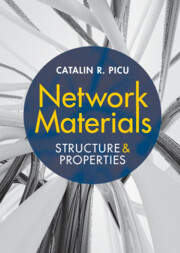Book contents
- Network Materials
- Network Materials
- Copyright page
- Contents
- Preface
- 1 Introduction
- 2 Fibers and Fiber Bundles
- 3 Fiber Interactions
- 4 Network Structure and Geometric Parameters
- 5 Affine Deformation
- 6 Mechanical Behavior and Relation to Structural Parameters
- 7 Constitutive Formulations for Network Materials
- 8 Strength and Toughness of Network Materials
- 9 Time Dependent Behavior
- 10 Networks with Fiber Surface Interactions
- 11 Composite Networks
- Index
- References
6 - Mechanical Behavior and Relation to Structural Parameters
Published online by Cambridge University Press: 15 September 2022
- Network Materials
- Network Materials
- Copyright page
- Contents
- Preface
- 1 Introduction
- 2 Fibers and Fiber Bundles
- 3 Fiber Interactions
- 4 Network Structure and Geometric Parameters
- 5 Affine Deformation
- 6 Mechanical Behavior and Relation to Structural Parameters
- 7 Constitutive Formulations for Network Materials
- 8 Strength and Toughness of Network Materials
- 9 Time Dependent Behavior
- 10 Networks with Fiber Surface Interactions
- 11 Composite Networks
- Index
- References
Summary
This chapter presents a comprehensive overview of the mechanical behavior of Network materials, with emphasis on the structure–properties relation. Crosslinked and non-crosslinked Network materials are discussed in separate sections. The behavior of crosslinked networks in tension, shear, compression, and multiaxial loading is described. The effects of fiber tortuosity, fiber alignment, crosslink compliance, network connectivity, and variability of fiber properties on network stiffness and nonlinear behavior are discussed in detail. The size effect on linear and nonlinear material properties is evaluated in relation with network parameters. Three types of nonlinear behavior are identified, corresponding to networks that stiffen or soften continuously during deformation, and networks with an approximately linear response. Numerous examples of each type are presented, including collagen networks, fibrin and actin gels, elastomers, paper, and nonwovens. The response of non-crosslinked athermal networks, such as fiber wads, is studied in compression and tension. The effect of entanglements in athermal networks is analyzed and a parallel drawn with the mechanics of thermoplastics.
Keywords
Information
- Type
- Chapter
- Information
- Network MaterialsStructure and Properties, pp. 146 - 251Publisher: Cambridge University PressPrint publication year: 2022
